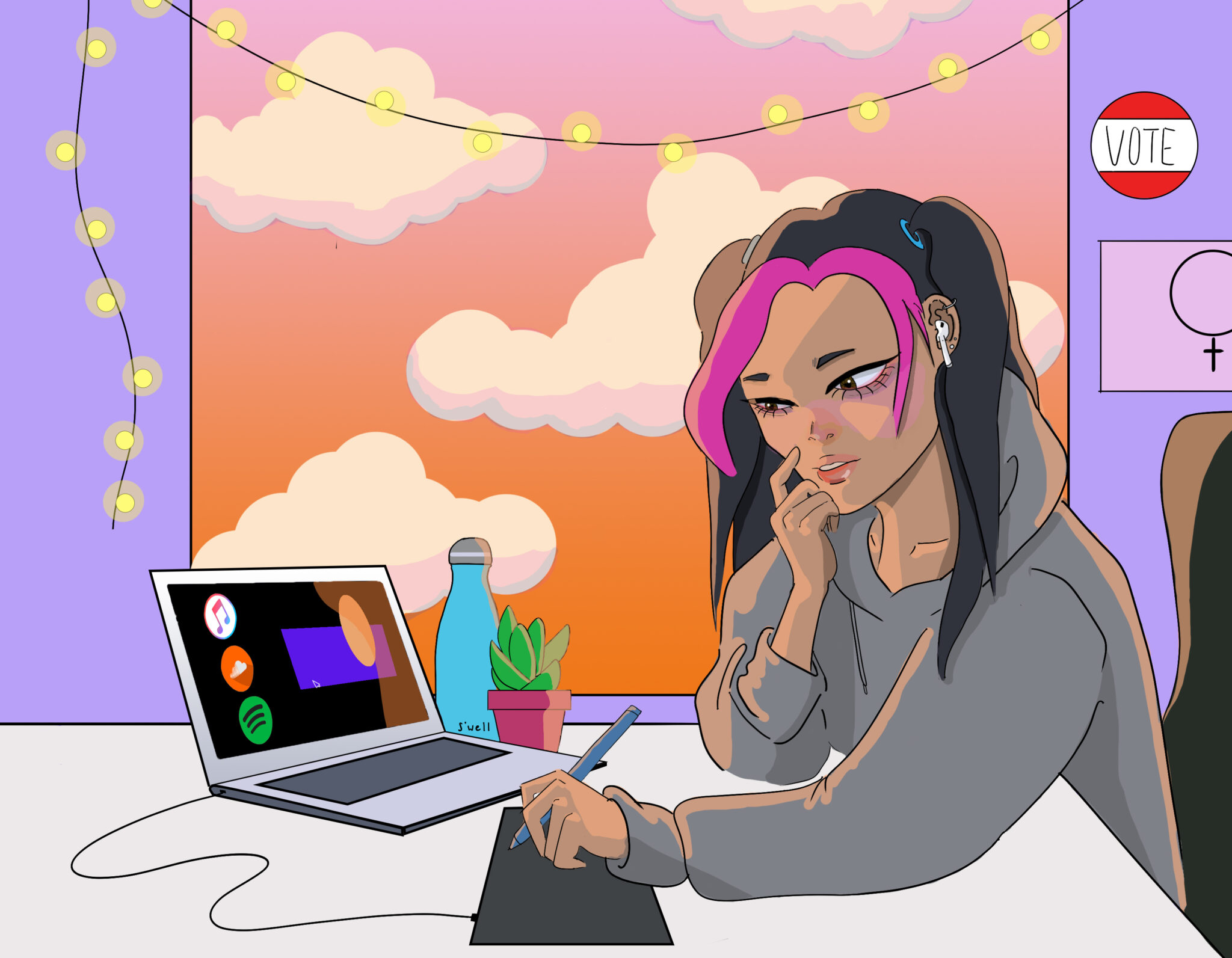GRAPHIC DESIGNER Mia Portelance
There is something about non-lyrical music that can make you feel like you are living within your own personal film. Music that allows you to focus outside of your own subconscious prompted by simplistic mixtures of beats and samples – this is the beauty of lo-fi sound.
The growing popularity of lo-fi music has taken listeners by storm through music streaming platforms such as YouTube, Spotify, Soundcloud, and more; the ability to help people feel mentally relaxed is the main focal point for the genre’s growing success.
Icons such as the “lo-fi girl” have gained internet popularity as a result of lo-fi music streaming. Arguably the most prominent radio live stream is ChilledCow’s ”lofi hip hop radio – beats to relax/study to” on YouTube: a never ending stream of countless lo-fi tracks, along with thousands of listeners gathered to chat and study alongside the lo-fi girl. Just like the hip-hop or pop music community, the lo-fi music community exists, not through big record companies but through the minds of its listeners.
What is Lo-fi Music?
Lo-fi music is often referred to as “low fidelity” music. Low fidelity music production involves the incorporations of technical distortions within the sampling and editing process of soundtracks. Known as being undifferentiated, lo-fi music merges various genres of instrumental music and sounds in order to create the mellow-grainy harmony that listeners enjoy.
According to a Music Gateway blog post, lo-fi music originates back to the 80s and 90s where it was formerly known as DIY music. Back then, artists had utilized drum machines and samplers in order to produce mellow relaxing sounds – essentially laying the groundwork for the lo-fi music artists of today. Its slow tempo, lack of words, and ability to invoke nostalgia can be a powerful aid to relaxed work.
Lo-fi, But Therapeutic
Besides being euphonious this genre of music is also widely known for helping listeners relax and increase productivity levels for studying/working.
Research referred within a Washington Post article about lo-fi music suggests that the use of music distortions and sound variations allows the brain to focus on specific sounds, therefore enhancing attention levels. Essentially, effective work music should not excite feelings that are positive or negative; rather it should be able to find that median that stimulates relaxation.
This escape in music serenity allows for listeners to vibe to ambient soundtracks, where many YouTube lo-fi channels provide a live chat directly built into the music experience. This enables listeners to relax and chat with others while also maintaining a certain intimacy that is lacking in normal musical experiences (such as listening to music on your own). This safe space offers a therapeutic session for listeners to ease their anxiousness, which allows them to escape their busy lives in order to get back into a productive workflow or to simply unwind for the night.
Similar to how people use apps such as Headspace or Calm to relax, the genre affects the listener’s mood and tunes out all distractions to allow focus. The music hones in on a vast variety of sounds that showcase various genres and atmospheres. Having the music regulate moods through the positive effects with cognition has correlations into personal productivity.
Local Artists
Although the lo-fi music industry is small and unknown, many artists go under the radar so it’s hard to notice that the artists you like live and produce their music within your city. Toronto for instance, has an abundance of low-key lo-fi artists/producers that create the music right from their very homes.
Here are some notable artists within and near the Greater Toronto area:
NOMVDSLVND
Also known as Nigel Edwards, NOMVDSLVND (pronounced ‘nomads land’) is an alternative, electronic and instrumental music artist based in Toronto. NOMVDSLVND has grown wide popularity for his recently released soundtracks More Harm Than Good Part 1: Here for Now and More Harm Than Good Part 2: Nowhere Is Home which can be streamed on Spotify and SoundCloud.
Biosphere
With over 500,000 monthly listeners on Spotify, Biosphere is a Taiwenese Canadian producer based in Toronto. His focused genres are chillhop, lo-fi hip hop while also experimenting with trap and RnB. He has so far released four albums, eight singles and has made multiple appearances on other popular artist’s work.
Limes
An artist based from the outskirts of the Greater Toronto area, Limes is a hip hop beat maker from the town of Newmarket. Limes’ work has frequently appeared on various volumes of ChillHop playlists – a very popular streaming channel that compiles popular lo-fi hip hop music. As a mainstream artist within the lo-fi music industry, Limes has over 650,000 monthly listeners on Spotify.
A Playlist to Start
Want to start listening to lo-fi and don’t know where to start? Here is a top 10 list of my personal lo-fi music favourites consisting of local and international artists that I enjoy working and studying to:


























